Programmatic SEO is an advanced strategy that leverages automation to create and manage large-scale SEO campaigns. By programmatically generating a vast number of unique, targeted landing pages, websites can significantly boost their search engine visibility and drive organic traffic. This approach is particularly effective for sites with extensive product listings or user-generated content, allowing them to optimize for a wide array of keywords efficiently.
What is Programmatic SEO?
Programmatic SEO, often called pSEO, involves creating many landing pages quickly to rank on search engine results pages (SERPs). Each landing page starts from a uniform template containing consistent elements like images, pricing, and reviews. Automated tools are then used to generate variations of these pages, each targeting a different low-competition keyword.
For instance, when you search for “top hotels in [location],” you will likely see an Expedia page among the first results. This is because Expedia uses programmatic SEO to create pages like “top hotels in Florida” and “top hotels in California.” While the layout remains consistent, the content is customized for each location. This large-scale creation of landing pages from a template is the essence of programmatic SEO.
Regular SEO vs. Programmatic SEO:
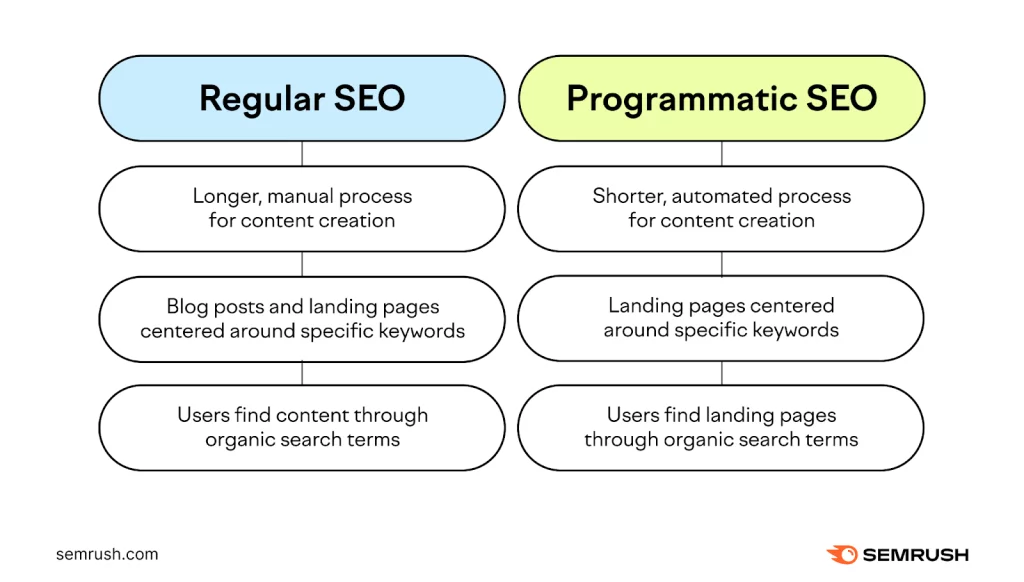
Both programmatic SEO and regular SEO aim to increase organic traffic, but they differ in their approaches. Regular SEO is a long-term strategy focused on high-quality content. It involves creating unique blog posts and landing pages centered around specific keywords, often targeting higher competition keywords and taking longer to produce.
In contrast, programmatic SEO is faster at achieving similar goals by generating numerous landing pages with an identical layout using databases, templates, and automation. These pages target low-competition keywords to rank on search engines quickly. Despite these differences, both methods require thorough keyword research.
Pros and Cons of Programmatic SEO
Advantages:
- Scalability: Once you build a landing page template, you can easily create many pages.
- Comprehensive Keyword Targeting: You can target full categories of keywords, increasing the chances of ranking for various searches.
- Increased Visibility: Targeting low-competition keywords boosts search visibility.
- Backlink Opportunities: More visibility can lead to more backlinks.
- Sales Potential: Targeting ready-to-buy audiences can increase sales.
Considerations:
- Technical Skills: Creating a programmatic SEO template requires coding skills.
- Upfront Costs: Investing in no-code tools involves higher initial costs.
- Content Quality: Low-quality or duplicate content can violate Google’s Spam Policies.
- Indexing Challenges: Ensuring all pages are indexed can be tricky.
- Ongoing Maintenance: Programmatic SEO requires continuous monitoring and updates.
The Three Pillars of Programmatic SEO:
An effective programmatic SEO strategy hinges on three main elements: low-competition keywords, search intent, and user experience (UX).
- Low-Competition Keywords
Programmatic SEO targets keywords with lower competition to increase the chances of ranking. These keywords are identified using a metric called keyword difficulty (KD). Keywords with a KD between 0 and 29 are ideal for programmatic SEO as they are easier to rank for. Thorough keyword research is essential to find these terms.
- Search Intent
Understanding search intent—the primary goal of users landing on your site—is crucial. There are 4 types of user intent: navigational, informational, commercial, and transactional. Programmatic SEO typically focuses on keywords with commercial or transactional purposes, such as “Amazon Kindle Paperwhite cover” or “Amazon Kindle Paperwhite review.” Pages targeting these intents are aimed at users ready to purchase, which can lead to higher conversion rates.
- User Experience (UX)
A positive user experience is essential for retaining and converting visitors. Automated landing page creation can sometimes compromise UX, so it’s essential to ensure pages load quickly and contain unique, valuable content. For example, review sites like G2 have thousands of pages with the same layout but maintain high quality and fast loading times. While automation tools can help generate these pages, human intervention is necessary to ensure the content is unique and engaging.
Using templates with AI-generated copy solely for ranking purposes can result in penalties for low-quality content, which Google refers to as “doorway pages.” To avoid this, try creating valuable content with an appealing design and unique text.
- Conduct Niche and Competitor Research
Begin by thoroughly researching your niche to finalize the format of your landing pages. Analyze how other websites in your niche, including your competitors, have designed their landing pages. This will help you understand what works well in your niche. Draw inspiration from these examples and develop your ideas accordingly.
Consider your target audience and how you plan to engage them. This could involve various use cases of the same products, different geographical locations, or other relevant factors. Utilize online competitor analysis tools to identify websites targeting your exact keywords. Study these competitors to see how you can differentiate your business.
- Identify Head Terms and Modifiers
Before conducting comprehensive keyword research, identify relevant head terms and modifiers. Head terms are the primary category keywords related to your niche, while modifiers transform these main keywords into long-tail keywords. This process helps you discover less competitive long-tail keywords that attract the right audience.
For example, run a hotel chain targeting different locations in India. You might use the header “best hotels” and the modifier “in Gurugram” to create the long-tail keyword “best hotels in Gurugram.” Similarly, if affordability is your unique selling proposition, combine “best hotels” with modifiers like “in Gurugram” and “under x” (where x is a specific amount) to form “best hotels in Gurugram under x.”
- Select the Long-Tail Keywords to Target
Once you have identified relevant head terms and modifiers, combine them to generate a comprehensive list of keywords. Not all of these keywords will align with user search intent. Use a keyword research tool to find the search terms with low keyword difficulty (KD). Apply filters to set the KD to ‘easy’ and select the relevant ‘intent.’
If you target users with both transactional and commercial search intent, repeat the process for each intent to compile a list of suitable keywords. Create additional keywords based on the locations and audience types you are targeting. Discard keywords that don’t allow further variations in your programmatic SEO strategy.
- Build a Template for All Landing Pages
Building a standard template for your landing pages is crucial. The template should be designed to appeal directly to your target audience. While the layout remains consistent across pages, the information must be unique to comply with Google’s guidelines and avoid penalties.
Focus on the content and design elements you want to include, such as location, prices, and reviews. Follow these steps to create your template:
- Choose a Website Builder: Select a page builder offering multiple template options. You can use no-code builders to create your template even without coding knowledge.
- Select a Database: Store the information for your landing pages in a database, such as an Excel sheet.
- Use Copywriting Tools: Generate content for your pages with copywriting tools, but ensure human editors review and refine the content.
- Integrate Tools: Use integration tools to connect your database with the website builder software and automate the creation of your landing pages.
- Publish Pages and Ensure Indexing
Indexing can be challenging with programmatic SEO due to the many pages created. Search engines may not index all pages immediately. If your indexing rate is below 30%, don’t panic; pages are often crawled but not immediately indexed. Ensure each page offers unique information to help search engines recognize their value.
To improve indexing rates, consider these strategies:
- Internal Linking: Develop a solid internal linking structure and identify optimal linking opportunities for each page.
- HTML Sitemaps: Create sitemaps with a category > sub-category > pages structure for better internal linking and crawlability, increasing the chances of pages being indexed.
- Enhance User Experience
Google prioritizes websites which provide a good user experience. To improve your site’s visibility, ensure your web pages meet user expectations. The content and information on your pages should match the meta titles that entice users to click on your URL. Design visually appealing pages with clear, easy-to-understand formats and intuitive navigation.
Well-written content and clear calls-to-action (CTAs) are crucial for a positive user experience. Monitor all pages post-launch to identify and fix any errors, ensuring a seamless experience for users.
Real-Life Examples of Programmatic SEO:
#1 Nomad List
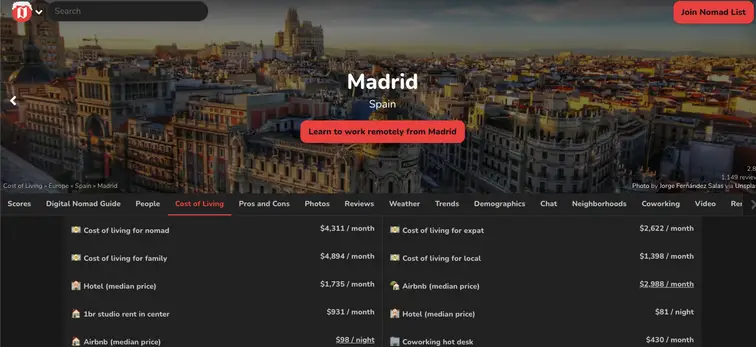
Nomad List is a renowned platform that offers valuable information for digital nomads. It helps remote workers find the best places to live, work, and travel. The site aggregates millions of data points every second to provide insights on various locations, making it easier for digital nomads to choose their next destination.
Nomad List leverages programmatic SEO extensively, creating numerous city pages that target specific keywords like “Best Places to Live in [Continent],” “Cost of Living in [City],” and “Cheap Places in [Country].” For instance, their “Cost of Living” pages display data points without much-written content, effectively ranking for these search terms.
Top 11 Essential SEO Settings for WordPress Blog – Nestify
#2 Canva
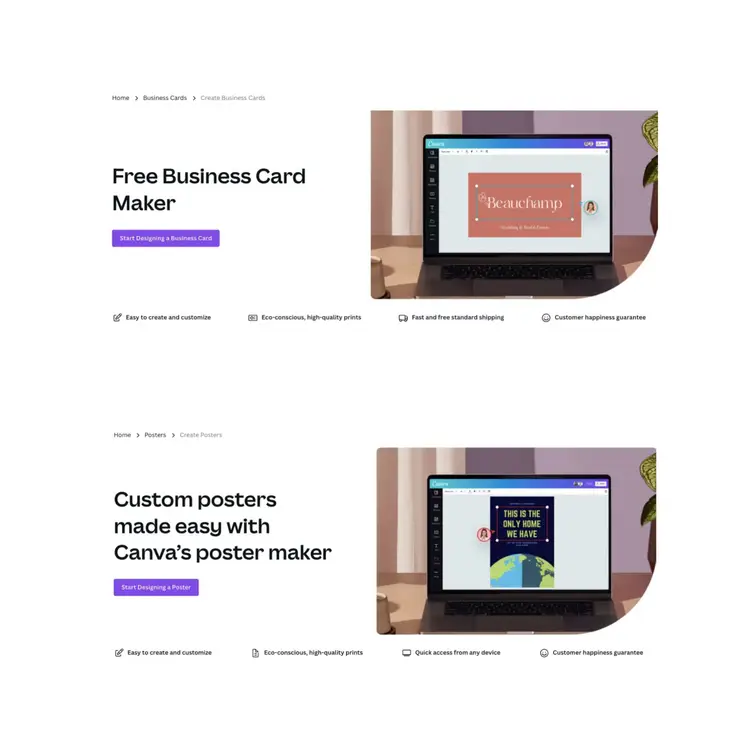
Canva is a widely used free graphic design platform that allows users to create various designs using a vast array of templates, such as invitations, business cards, and Instagram posts. The platform simplifies photo editing and design customization and employs a strategic approach to SEO.
Canva uses programmatic SEO by creating page templates with different content tailored to various search intents. Their landing pages maintain a consistent structure, but the content within each page is uniquely optimized for specific keywords.
The success of Canva’s programmatic SEO strategy lies in understanding search intent and creating separate pages for each keyword. For example, a user searching for “create a certificate” wants to design one independently, whereas someone searching for “free certificate template” is seeking downloadable templates. Canva’s approach ensures that each search query is met with highly relevant and optimized content, enhancing user experience and improving search rankings.
#3 Zapier
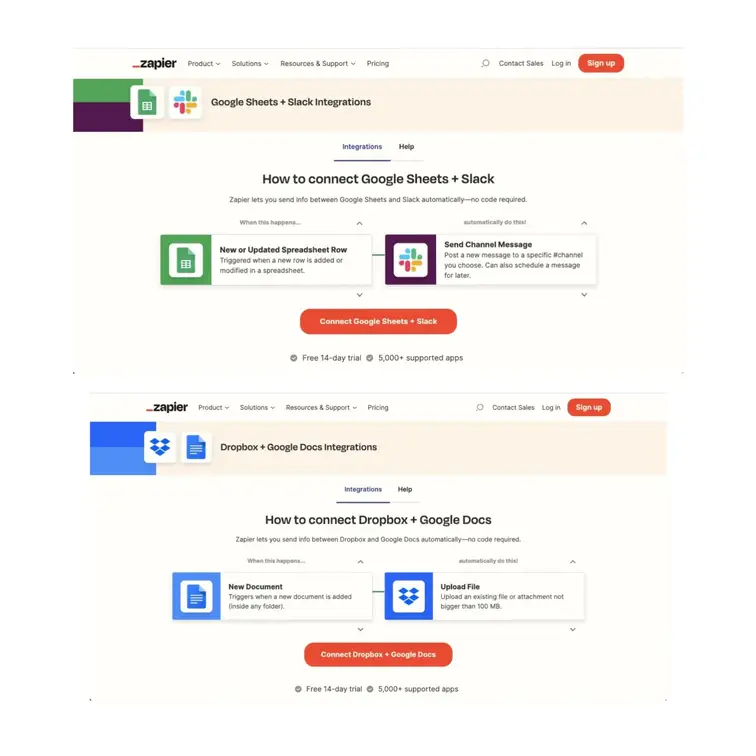
Zapier has effectively utilized programmatic SEO by creating thousands of pages integrating various tools, such as “Google Sheets + [platform] integration.” These pages lack traditional written content and instead feature dynamically inserted data, including “Zaps,” triggers, and tutorial links.
This SEO strategy has been highly successful for Zapier, driving two million visitors through approximately 56,000 pages in May 2022.
#4 Booking & TripAdvisor
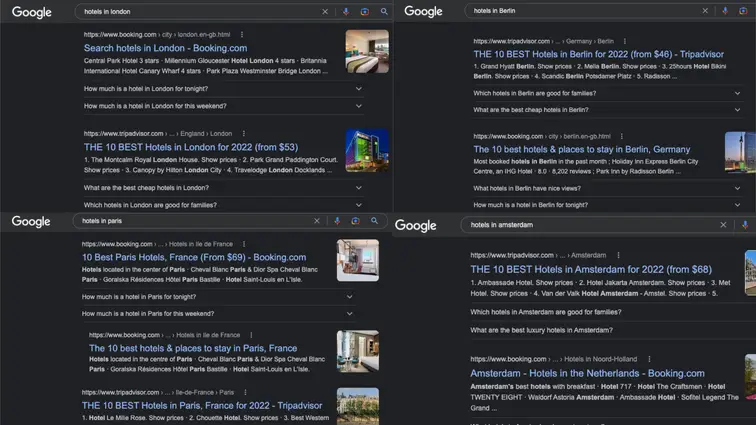
Booking.com and TripAdvisor consistently rank at the top of Google searches due to their extensive use of custom landing pages. Searches for “hotels in [city]” often see these sites in the top results.
By identifying key terms and modifiers, these platforms create a unique formula for each content piece (e.g., “[The cheapest] [hotels] in [Paris]”), resulting in thousands of custom landing pages for nearly every city worldwide. This approach ensures they maintain top positions on Google.
Boosting ROI: 9 Enterprise SEO Tools to Drive Tangible Results for Businesses – Nestify
#5 Eater
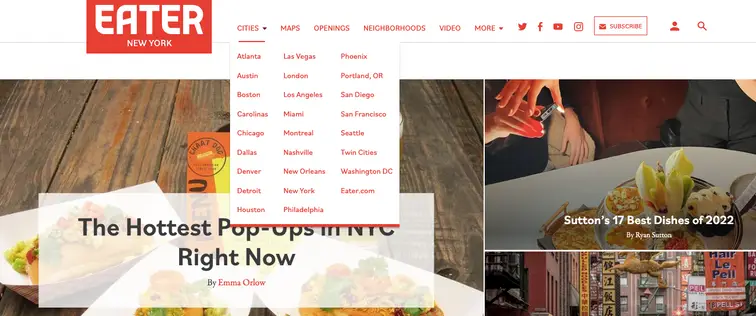
Eater.com has implemented a similar strategy to Booking and TripAdvisor, focusing on food, wine, and restaurant content.
Eater generates unique content by combining lists of cities with various types of food and restaurants. This method helps Eater rank highly in search results and attracts visitors looking for “the most delicious Italian Four-Cheese Pasta” 🍝.
#6 Webflow
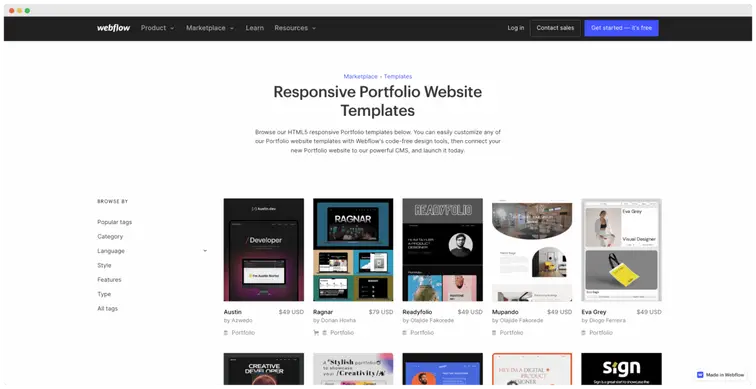
Webflow has created programmatic pages for their website templates, targeting keywords like “Responsive [type] Website Templates.
Like Canva, Webflow’s programmatic SEO strategy has proven highly effective, demonstrating that this approach is ideal for projects requiring extensive, dynamically generated content.
#7 Yelp
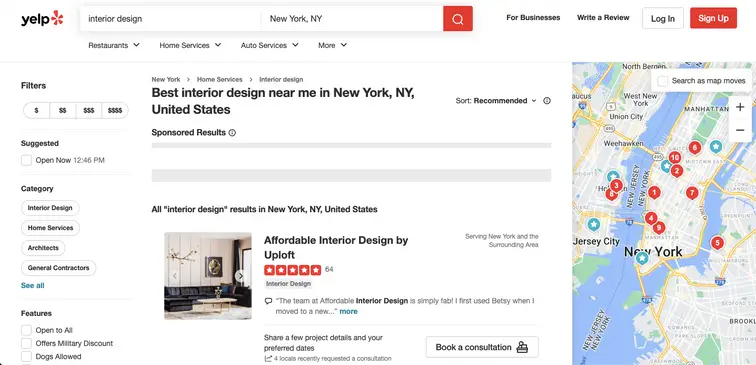
Yelp empowers consumers to discover, connect, and transact with local businesses of all sizes by offering trusted information, photos, and review content. Users can make appointments or purchases, request quotes, join waitlists, or make reservations directly through Yelp.
By creating specific categories for cities, local businesses, and services, Yelp leverages programmatic SEO and target long-tail keywords to drive over 135 million monthly visits. This strategy has helped Yelp secure a position in the top 3 search results, making it a formidable competitor to Google Reviews.
#8 ProductHunt

ProductHunt is a popular platform that helps makers and marketers launch their products and gain initial users. Programmatic SEO has played a crucial role in making ProductHunt one of the top community-based sites.
ProductHunt creates alternative pages for products listed on their site. For instance, when searching for alternatives to Notion, ProductHunt displays the top 3 alternatives and offers a full list of over 270 products. This approach has resulted in nearly 300 landing pages for a single product query, contributing to their extensive database of over 100 million products across 50,000 companies as of 2016.
#9 Amazon

Amazon SEO involves optimizing product listings to enhance their visibility and ranking in Amazon search results, a principle that applies to their Google visibility.
Amazon uses several factors related to user behavior to determine the relevance of product listings to a user’s search. For example, if a product is frequently purchased following a specific search query, it is deemed highly relevant.
Conclusion:
Programmatic SEO is a game-changer for businesses looking to maximize their online visibility and drive organic traffic. By leveraging automation and data-driven strategies, companies can efficiently create and optimize a vast number of landing pages, ensuring they meet the search intent of a wide range of queries. As demonstrated by industry leaders like Zapier, Booking.com, and ProductHunt, this approach not only enhances search engine rankings but also significantly boosts user engagement and conversion rates.



